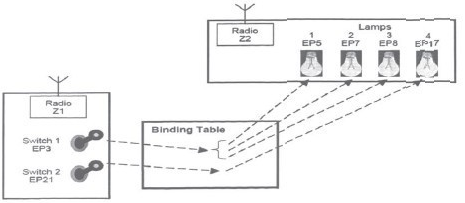An Overview of Common Zigbee Terminology
When studying the Zigbee protocol stack, one often encounters terms such as application, Zigbee Device Object (ZDO), node, device, endpoint, cluster, attribute, binding, addressing, and other Zigbee terminology. This article will clarify what these Zigbee terms represent, how they are defined, how they are distinguished, how they are categorized, and the relationships between them.
1. Attribute
An Attribute is a data value that reflects a physical quantity or state, such as switch value (On/Off), light status (On/Off), temperature value, percentage, etc.
2. Cluster
A Cluster is a collection of one or more attributes. In simple terms, a cluster is a set of attributes. Each cluster is assigned a unique cluster ID, and each cluster can have up to 65536 attributes. For example, a cluster may include different states of a switch, different states of a light, different temperature values, and different percentages under various conditions.
3. Device Description
A Device Description refers to a part of a larger target application, which includes one or more clusters.
4. Endpoint
An EndPoint is the entry point of the application layer of the protocol stack, which can also be understood as the location where the application object exists. It is a set of clusters defined to implement a device description. Each Zigbee device can support up to 240 such endpoints, with endpoint 0 used for the configuration and management of the entire Zigbee device. Applications can communicate with other layers of the Zigbee stack through endpoint 0 to initialize and configure these layers. Objects attached to endpoint 0 are referred to as Zigbee Device Objects (ZDO). Endpoint 255 is used for broadcasting to all endpoints, while endpoints 241-254 are reserved endpoints.
5. Profile
A Profile can be understood as a collection of multiple device descriptions that facilitate interactive applications. It defines the attribute IDs and cluster IDs, making them appear as certain characteristics of the device. For example, in a home automation system, the light profile specifies that the remote control device’s cluster OnOffDRC contains an attribute OnOff, which is an unsigned 8-bit value where 0xFF means “on”, 0x00 means “off”, and 0xF0 is invalid. Typically, a profile also defines which clusters are mandatory and which are optional. Additionally, the profile defines some optional Zigbee protocol-hosted services. Each application corresponds to a profile, which includes information such as Device ID, Cluster ID, Attribute ID, and the type of service used by the Application Framework (AF). In the Zigbee protocol, a profile can accommodate up to 2^16 devices and 2^8 clusters, with each cluster supporting up to 2^16 attributes.
6. Node
A Node can also be understood as a container that includes a set of Zigbee devices sharing a wireless channel. Each node has only one wireless channel. In addition to a 64-bit IEEE address and a 16-bit network address, each node also provides an 8-bit application layer entry address (endpoint: EndPoint), corresponding to the user application object.

Node One Z1: Switch control device;
Node Two Z2: Light device;
Event: Switch 2 controls the on/off state of light 4, while switch 1 controls the on/off state of lights 1-3;
Cluster: The states of switches and lights under different conditions;
Endpoint: Switch and light;
Attribute: Both switches and lights have two attributes: on and off.
7. Binding
Zigbee defines a special process called endpoint binding. Binding creates a logical link between a certain endpoint of a source node and a certain endpoint of a target node. Binding can occur between two or more devices. The coordinator node maintains a binding table that essentially includes the logical links between two or more endpoints.
The binding table contains information such as the IEEE addresses, endpoint numbers, and cluster numbers of the source and target nodes. For two nodes that can establish a binding relationship, one of their cluster attributes must be selected as “input” and the other as “output”, and the cluster numbers must be equal; only then can they establish a binding with each other. If the extended address of the target device is known, the function zb_BindDeviceRequest() can be called to create a binding entry.
8. Addressing
In a Zigbee network, two types of addresses are used: one is the 64-bit IEEE address, also known as the physical address, which is unique among all Zigbee devices and contains a 24-bit manufacturer-specific organizationally unique identifier (OUI) assigned by IEEE. The other is the 16-bit network address (NWK Address), which is obtained from the parent device that allows it to join the Zigbee network. This address is unique within the Zigbee network and is used for data transmission and packet routing. In Zigbee, packets can be sent as unicast, multicast, or broadcast, so an address mode parameter must be specified. A unicast packet is sent to a single device, a multicast packet is sent to a group of devices, and broadcast data is sent to all nodes in the network. When an application needs to send a packet to a group of devices on the network, group addressing can also be used.
If you are interested in DIGI products, please contact: Manager Wu 18611101552.

Recommended reading of previous articles (click on the article title to read directly):
1. An Overview of Digi Xbee Module AT Commands;
2. An Overview of Digi Xbee Module Transparent and API Modes;
3. From XBee-Pro ZB (S2C) to XBee3 ZB3.0;;
4. Notice to Users: About Communication Issues Between XBee3 and S2C;;
5. Digi XBee Module Outdoor Communication Distance Testing Guide;
6. An Overview of Digi Wireless Solutions in the Field of Industrial Drones;
7. An Overview of Digi Wireless Routers in Remote Data Transmission Applications for Urban Traffic Management;
8. A Well Monitoring System Based on ZigBee Wireless Technology;
9. An Intelligent Traffic System Based on Digi XBee;
10. How Many Companies Are There in China Making Wireless Target Devices?